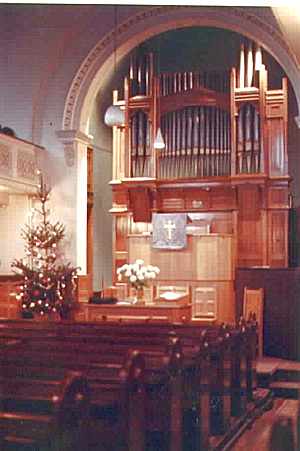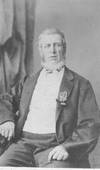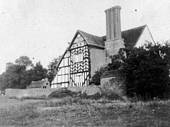|
|
Of the early records of the old Congregational Church (which contained The Needlemakers Graveyard) only some have been preserved but fortunately one interesting entry has been traced - the baptism on October 28th 1828 of Ellen, daughter of William and Elizabeth Webb (father's occupation - fish hook maker). Perhaps he was married at the Congregational Church, which is, after all, in Evesham Street where we know he was living. Another possibility is that his wife was Elizabeth Long, who married a William Webb at St Philips, Birmingham in the spring of 1828. The witness was a James Webb, so this is a good "match" (!) of date, church and names. Their married life in Redditch was of only short duration - Ellen was buried there only 19 months later, and the following year (July 1831) we find - Burial, Elizabeth Webb, aged 33 years, wife of William Webb of Redditch, fish hook maker. THE HISTORY OF REDDITCH CONGREGATIONAL CHURCH In 1822 a group of needlemakers met with their employer Thomas Williams to discuss religious matters which were of great concern to them. They sought a freedom of worship which was not to be found in Redditch at the time. Williams had been converted by preachers of the Wesleyan traditional, but he and his workers sought a fuller type of non-conformity. Williams decide to offer a site of some two acres next to his factory in Evesham Street, and the foundation stone for the new church was laid in July 1825. Sadly, Williams died in September of that year, but from his considerable fortune he left money to build the church, with bequests also to the British and Foreign Bible Society, and to the London Missionary Society. In June 1828 the covenant was formed for "The Independent and Congregational Church" and some members of the Webb family were part of the congregation at the start. Unfortunately only a few of the records of the church have survived, but we know of the baptism of William Webb's daughter, and of the burial of this daughter, and of his first wife (see above). The list of members from 1830 shows a James Webb, who is noted to have left (but when?). Two daughters of a James and Elizabeth Webb (he a needle finisher) were christened at the church - Eleanor in February 1845 and Elizabeth Ann in February 1848. The church buildings were completed in phases - first the chapel and the vestries, then a school hall in 1889, and a suite of ten rooms in 1910 (this built on the site of the Littleworth orchard). The church served the needs of the populace of Redditch not only in the spiritual sense but also in the field of education and leisure. Long before the 1870 Education Act churches such as the Congregational church ran Sunday Schools, which offered to both adults and children the opportunity to learn to read and write. The classes were held on a Sunday, the only day of leisure for the workers. Clubs and societies were run from the rooms, often with the aim of offering an alternative to sitting drinking in the pub. A tennis court and a bowling green were later added.
The church continued to thrive
until it was threatened by the New Town Development plans which
were revealed in 1964, and the church building was scheduled
for demolition (the congregation was offered alternative accommodation
within the Ecumenical Centre). Of course a church is more than
a building, it is above all a community of believers, but the
loss of the building was a severe blow and much lamented by the
town. By a curious twist of history, descendants of the original
Webbs had been worshipping at the Congregational church in Redditch
from the late 1940s onwards, but ignorant of the previous connection.
When the remains of those buried in the small burial ground,
known as the Needlemakers' Graveyard, had to be re interred,
they were asked if they wished to be present, as the names of
Ellen Webb and Elizabeth Webb appeared in the burial records.
Regrettably we did not then know who they were, but can, through
this account, put the records straight. |
|
|
John Hickley was a noteable and valued citizen of
the town of Aldershot - he is highly spoken of in his obituary
of 1898. He was a member of the first School Board in Aldershot,
a Freemason, and staunch churchman. He later developed a coal
business taking in his nephew, a Mr Alderton. John and Emily moved to Upton
House, Hale, near Farnham, but he continued his interest in the
coal trade, a business which had also attracted the attention
of his brother-in-law Thomas Edward Webb, who lived in Aldershot
for a time, and may have been a partner in the firm. Despite frequent poor health, John Hickley evidently couldn't resist getting involved in new enterprises. At the time of his death it was electricity which had taken his interest, his last illness being attributed "to the excitement occasioned by a scheme he was considering for the installation of electric light to his house, and to the fatigue consequent on a ride in his motor carriage at Easter to see the procession of motor cars on their way to Portsmouth"! John and Emily Hickley had no children, but took a great liking to one of Thomas Edward's brood, and young Gertie was a frequent visitor, almost a permanent guest. By the 1901 census Ellen Hickley now a widow, had moved to Leamington, and is found there with her sister Emma Cranmore (also a widow) and Gertie. |
|
|
In the 1881 census
James and Emma Cranmore were living in Upper Grove Street,
next door to the now widowed Susannah, but at the time of his
death in 1890 James was living in Melen Street, still owning
the house in Upper Grove Street. Emma lived at number 19 and later at number 39 Melen Street (unless the house numbers changed, and it was in fact the same house) until her death in 1928 at the age of 93. The author's father, John, remembered being taken to visit his formidable Aunt Cranmore in Melen Street, and being rewarded with a sovereign! (a coin worth £1). She was perhaps especially generous having had no children of her own. |
|
Return to text |
At the time of his
marriage to Sarah Hollington, William was 39, describing
himself as a corn dealer, while Sarah was 28 and had been a draper's
assistant in the Hollington family shop. The marriage took place
by licence at Wolverley church, although Sarah had been born
in Kinver (which on her birth certificate is spelled Kinfare).
Her family had moved to Wolverley having been farmers at Kinver.
William and Sarah set up home above the shop in Evesham Street, and very soon had a young family - William Harvey was christened at St Stephen's in 1881, Arthur Ernest in 1882, Lillian Mary in 1884, and Emily Gertrude in 1885. |
|
|
John Cheer and his wife Ann had moved from Great
Marlow to Bray, near Maidenhead, to Battle Farm at Edge Hill,
from there to Harbury, Warwickshire, and then to Tookeys Farm
at Feckenham, acquiring in the process six daughters who survived
infancy (two who did not), and one son (who, as a young man,
broke his apprenticeship and ran away, perhaps being scarred
for life by such a dominant female presence in the family!). |
|
|
A TRIPLE MARRIAGE "Marrying and giving
in marriage" is an injunction - a promise- which meets with
ready acquiescence. It is not often that we hear of three weddings
in one day in a family; and the announcement that three charming
daughters of a former townsman - Mr Cheer - were led to be willing
sacrifices to the Hymeneal altar, created quite a new sensation;
and, on Tuesday morning last, our streets assumed an appearance
of life and bustle altogether unusual. Carriages, with the horses
and coachmen adorned with white favours, were to be seen conveying
the bridal party; whilst large numbers of persons hastened to
the Parish Church, evidently anxious to witness the ceremony.
It is only right to state that the ladies turned out in by far
the greatest numbers; and among them the expectation, animation,
and excitement arose to a great height: while the event of the
day was discussed with womanly eloquence and warmth. Some ill-natured
fellows even went so far as to remark that many a fair face looked
with a feeling akin to envy on the happy brides, as they passed
in triumph down the nave of the church. The brides with their
attendant maids, were most becomingly and prettily attired; the
predominant colours being red, white and blue. The eldest daughter, Mary
Ann Lyford Cheer, married Henry Clark, a baker from Buckinghamshire.
Charlotte married Charles Scriven, a draper from Studley,
and 20 year-old Catharine married Thomas Edward Webb,
a clerk from Redditch aged 32. The brides came from a robust
line of Cheers, several of whom lived to a ripe old age. |
|
Return to text |
Stoke Newington had been, like many a London suburb,
a pleasant rural village until the nineteenth century, when large
scale housing developments were started. Thomas and Catharine
arrived in the area at the peak of this housing boom, and Sandbrook
Road was part of a brand-new housing scheme catering for
clerks, commercial travellers and skilled craftsman. The census
of 1881 shows that their neighbours included a GPO clerk, an
assistant letter carrier, a printer, an ivory turner (pianos
were manufactured in the area), a tailor, an engraver and many
clerks. Most of these were of a similar age to Thomas and Catharine,
and also had young children. The town was especially popular
once the railway station opened in 1872, and by 1875 the population
of Stoke Newington was said to be expanding faster than similar
districts. Charles Dickens' Dictionary of London (1879)
notes that "Stoke Newington lies rather high on the north
side, a little to the north-east of Islington. Rents very moderate,
but perhaps a little higher than those of Islington, the situation
being more open and the houses of a somewhat superior character". By 1899 a correspondent writing to the local newspaper claimed that there was no room left for even one more house to be crammed in. The Booth Poverty Survey of 1898 (http://booth.lse.ac.uk) shows that the area around Sandbrook Road was, in socio-economic terms, "Fairly comfortable. Good ordinary earnings". We may wonder why Thomas moved to this particular suburb, but the reason would seem to be that from the 1850s many clothing and furnishing industries had been established in and around Stoke Newington, so there would be a high demand for needles of all kinds. |
|
|
The children
of Thomas & Catharine born at Stoke Newington The family of Thomas and Catharine suffered tragedies while living in Stoke Newington. In 1882 little Edith died at the age of 5 years 9 months, but they travelled back to Redditch by train to have her buried "back home". The family had to journey from London to Redditch once again in 1884, for the funeral of Thomas' mother Susannah. Her will states that Thomas was "of the City of London". In 1885 their third son, Harvey Gordon was born, and was christened at St Faith's, Stoke Newington. Tragically he died at the age of 18 months, on Boxing Day, just two days after the birth of his sister Gertrude Maude (Gertie). These events took place in New Barnet, a few miles to the north of Stoke Newington. Had the family moved, or was Catharine in a hospital? Was she there for her confinement, or because Harvey was ill? It must have been a very difficult Christmas for the whole family. Gertie was christened at St Faith's, back in Stoke Newington, and Harvey was interred at Redditch cemetery (yet another sad journey home) |


 interior,
1960s
interior,
1960s John
Cheer
John
Cheer  Tookeys Farm
Tookeys Farm